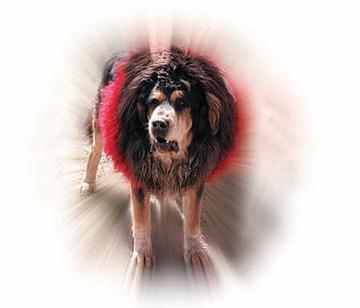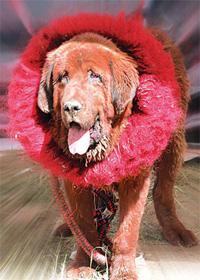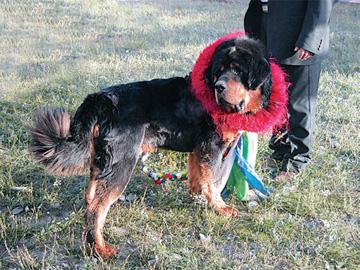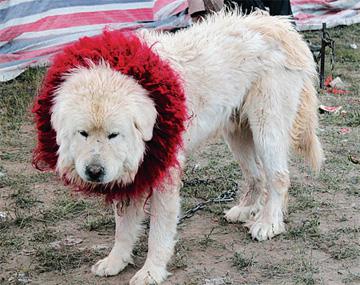Tibetan Mastiffs in Yushu
2008-09-25

A Tibetan Mastiff - Tanggya
When I was a teenager, my family had a baby mastiff. Because a lock natural of white hair decorated the mastiffs chest, he was given the name “Tanggya”. I remember Tanggya was a big dog when I was still a little girl. Whenever he stood on his hind legs, he seemed as tall as my father. When guests came to visit, he always jumped on them and barked constantly. Only my father could briefly calm him down, and nobody amongst our siblings dared to get close to him. Tanggya was never released until nighttime, but during the day he was always firmly restricted by an iron chain. The slightest sound in the surrounding district would immediately attract his vigilance. In response, he would bark all night and prevent the whole family from getting any sleep.

One night in winter, we did not hear any sound from him, which it was most unusual. Ama (meaning “mother” in Tibetan) guessed it was because there was no movement outside, but my older brother said it was because it was too cold and Tanggya might not want to leave his comfortable hut. Therefore, Apa (“father” in Tibetan) gave up his night patrol and everybody fell asleep... except me. At dawn, I heard Ama shouting and I immediately dressed and ran outside. There was no Tanggya! Only several marks made by his claws were left on the wall. Ama blamed Apa who did not get up last night for his night patrol. Apa signed deeply and said: “How could he possibly jump over the wall?” Then he went to search for him outside. When he opened the door we all were shocked to see Tanggya lying in the entrance sound asleep. Beside him was a bleeding goat. The frozen blood was coagulated on the goats neck. Obviously, Tanggya had killed the goat. Soon after, Apa tethered Tanggya with iron chains. I puzzled why Tanggya did not eat the goat, not even a bite?

Apa told me my grandparents had raised Tanggyas parents. His father was a famous mastiff in the grassland because he killed a bear. My grandpa was very proud of him for that. One day, amongst a flock of sheep, Tanggyas father held a dead sheep in his mouth. We guessed the sheep had slipped down a cliff. This was a really big sheep and enough to feed everyone in the family. Usually, an orthodox mastiff would never be hungry for food. Apa said Tanggya totally inherited his fathers characteristics as an orthodox mastiff. He could even catch and bite a wolf. Ama was worried that the owner of the sheep might come for an explanation. She insisted on leaving the sheep until its owner came, though Apa believed this was a lost sheep from far away. Ten days later, after nobody had claimed it, we all enjoyed the delicious lamb, while the internal part of the sheep was fed to Tanggya. Ama constantly wagged her tongue: “If one day the owner of the sheep came, I would like to pay him in cash...”
Several years had passed while Tanggya became older. We hardly ever saw his bravery like the feats of his youth. Naturally, it was also rare to hear his hysterical barking, except for an occasional crooning at night, seemly reminisced his passed glories. By day Apa started to let him free of his iron chains.
One noon on a school day, Ama found there was no Tanggya and saw the main entrance was open. Every one in the family worried so much and searched for everywhere. Finally, we found Tanggya on a hill close to our house, but he was almost at his last gasp. We took him back. Apa looked in dismay and repeatedly said: “He is an orthodox mastiff and a good one. Legend says an orthodox mastiff would never die in front of his owner. Maybe it is because he would like to maintain his dignity. He also does not like to make his owner sad. Anyhow, who knows?” I burst into tears. Ama said: “Dont be sad. He might reincarnate soon into a human being. Everybodymust experience being a dog in his/her previous life. Only by doing that, could people be given the opportunity to be a human being.” I prayed if Tanggya could be a herdsman in his coming life and wished he also raised a dog like himself to have a free life by running everywhere on the grassland.

For another ten years my family did not raise any mastiffs.
The Caged Mastiff - Parga
Since 2000 , my hometown Yushu has boomed because of the custom of raising Tibetan mastiffs - particularly in nomadic and semi-nomadic and agricultural areas. Almost 80 percent of the households of herdsmen have been involved. It is said that selling ordinary Tibetan mastiffs could earn an income of 150-300 thousand Yuan. Because the Tibetan mastiff is so profitable, some herdsmen become wealthy, and soon the residents in urban areas, such as public servants, secretly follow their example to raise mastiffs in order to grasp the benefits.
On the last day of the spring festival in 2006, my uncle came to visit us. He informed us his female mastiff had successfully delivered six baby mastiffs. He was a little bit sad because only one out of the six was a female mastiff since the female mastiff was more profitable than a male one. He generously asked if my family would like to have one. Ama and Apa politely refused because they disliked having any business dealings concerning mastiffs. Nevertheless, my husbandand also my three-year-old son were particularly happy to hear the news. They finally induced my parents to take a male mastiff from my uncle. Since the baby mastiff had a tiny white hair, we named him Parga. Following the contemporary approach to feeding a mastiff, the whole family exerted all efforts to take care of Parga. When he was two months old, my uncle brought a big iron cage and insisted on us keeping Parga in it. My father was puzzled and asked uncle why. He explained: “It is to prevent Parga from eating dead mice or rats which might undermine our efforts with Parga during the previous years. But if we tied him by the neck, it would result in stunting the development of his head. That is why I choose a cage - it is actually a completely safe plan. He might not get chance to exercise in the cage but he is still healthy. This is the contemporary approach to raise a mastiff.” Apa smiled and said: “It is hard to comprehend the modern generation. How could you cage a healthy dog? It will make him suffer a lot.” Nevertheless, we had to follow his instructions and caged Parga carefully. Whenever it was a sunny day, Apa liked to release him from the cage and let him wander in the courtyard to enjoy the sunshine. Quite often, we got some visitors. They liked to say that Parga could be sold for a high profit. No matter how many people came to visit him, Parga never lifted his head to look at them. He preferred to stick to his routine of eating and sleeping. We rarely heard him barking. Uncle always commented that Parga was a good mastiff and guaranteed that selling him would be profitable. However, Parga always seemed so different from Tanggya - a mastiff barking without a break, day and night.
Parga was already ten months old. People say, at ten months a mastiff has formed his mature shape already and will not grow anymore. However, businessmen trading in mastiffs judged that Parga was not a big profit maker. They decided that the height of Parga was not up to par and his head was not big enough either. They declared: “The white hair on his front feet show he is not a thoroughbred.” Uncle tried to convince us to sell him to those businessmen, and maybe we could have several thousand cash profit. Apa also complained that Parga did not bark. He believed that a silent dog would never be a good guarddog to protect the house and family. Thereby, both of them agreed to sell Parga. When my husband dragged Parga to a car, I suddenly felt regret. I regretted that I did not prevent them raising Parga at the very beginning. If I could have my time over again, I would like to keep my memory on the day when Tanggya died - sadness but not regret and worry.
Parga was sold for 1000 Yuan. Ama believed such a big amount of payment would not be paid just to slaughter Parga though we believed those mastiffs that did not meet the basic requirements as a mastiff would normally be killed for meat. On the second day, Ama took the 1000-Yuan payment to a monastery to pray for those slaughtered mastiffs, and wish they could be reincarnated soon as human beings.
Legend about Tibetan Mastiffs
I often heard a legend about the Tibetan mastiff. The story goes that in the broad grasslands, the staple food of nomads was mainly lamb, beef, and the flesh of leopards, bears and other wild animals. While grazing their domestic animals, male herdsmen liked to make arrows, bows, and knives for hunting. One day, a hunter suddenly met a fierce leopard that roared at him. The leopard appeared aggressive and intimidated the hunter. His face immediately tuned pale and he was not quick enough to raise his bow. At this moment, when all he could do was to wait to be killed by the ferocious animal, all of a sudden a giant dog jumped between them. The female dog barked aggressively, sounding like a lions roar. In a second, the two animals fought each other. The hunter was stunned. On seeing that the dog had caught a vital part on the neck of the leopard, the hunter recovered from his shock and quickly took out his knife and forcefully stabbed the chest of the leopard. With a sad roar, the leopard fell down. The hunter took the dog and the leopard home. Since then the dog accompanied the family of the hunter, taking care of them day after day. In order to express his gratitude toward the dog, the hunter called him “Tibetan mastiff”, referring to the Tibetan for a dog standing on the bow and arrow. The story soon attracted people to see
the dog, and they wished they could have one like this. As time went by, the giant dog got along with many wild monsters, such as bears, leopards, wolfs, and foxes. In his mating period, the dog mated with these monsters and delivered puppies, which looked either like bear, a leopard, a wolf, or a fox. Herdsmen then adopted all the puppies. Since then, they became the ancestors of various kinds of dogs on the grassland, including the ancestor of Tibetan mastiffs.
I dont know if I could trust this story or even get a sense of the provenance of it. But I believe that the Tibetan mastiff is a legend. His prestige, elegance, calm, bravery, intelligence and loyalty are always adored and revered by Tibetan herdsmen. All of these have contributed to the formation of the ancient civilizations of the ethnic Tibetans, and also the harmonious and sentimental relationship between Tibetan mastiffs and human beings. Decades ago and even today, though life keeps changing, the everyday relationship between
OTHER TIBETAN-INHABITED AREAS Tibetans and their mastiffs continue with mutual understanding
and appreciation - the common sentiments of living beings. How could people imagine that human beings would still be the owners of Tibetan mastiffs in view of the egotistical behavior of human beings in the world of Tibetan mastiffs?
Ancient civilizations have given birth to our modern generation, which is taking it upon itself to snuff out the pre-eminent and purified soul of the nation, replacing it with another kind of so-called modern civilization in order to push the most loyal companion of the Tibetan people to the edge of extinction. When more and more Tibetan mastiffs leave their home to live in unfamiliar places, the genius of Tibetan mastiffs will leave us. I can almost hear the mourning of Tibetan mastiffs that, having lost their spiritual home, have become a rare trophy for a few...
杂志排行
Tibet的其它文章
- The Mountain Summit Auspicious Clouds and Dreams—Recapping the Moment of the Olympic Torch Relay Leg
- The Fraternal Bond between Ethnic Tibetans and the Victims of the Wenchuan Earthquake
- The Train Carries Love from the Sunlit City to the Victims
- Paljor Lhunpo Today
- Tsakhalho:Salt Production and the Preservation of a Church
- Trees in Lhasa
